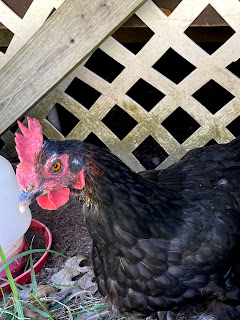It's fall!
Finally!
The thing is, it's hard to tell the change of seasons
in this neck of the woods.
There's no typical falling of autumn leaves
like the pictures show for northern climes.
There is a "tell" for us, though.
The bald cypress leaves go from dark green
to a beautiful rust color before falling.
The color is beautiful, but the mess
they make certainly isn't.
But,
I'll take the mess knowing that
we still have our cypress trees.
Thankfully a lot of the native flora
weathered Ida.
I guess their genetics made them more
sturdy than others.
Fall in City Park.
Beautiful...
******************************
The repairs are ongoing...
And...
the helicopters are still patrolling
Also,
the veggie garden is overgrown
but nothing is growing,
so it isn't a problem.
The plants in the front are finally perking up.
We moved what we could before
the storm to protect them,
but in the aftermath, with
no water for a while, they
didn't do so well.
We removed all the dead leaves
and the broken pieces so
they would have a healthy re-start.
***************
The girls scouting out the compost bin.
It is always a source of earthworms
or tasty kitchen scraps.
They are molting.
Their feathers are everywhere.
We always say that it looks
like they had a pillow fight!
Their molting also means no eggs.
They all molt at the same cycle.
It usually appears in late summer,
or early fall.
Chicken 101
Molting is a natural process that all
fowl undergo.
It replaces the old worn out feathers with
the new ones, but it also gives hens
a time to stock up on nutrients that
egg laying removes from their systems.
Did you know that most domestic chickens
have around 8000 feathers?
And,
not all those feathers molt.
The process of losing the feathers to
replacing them can take from 8 to 16 weeks!
That's why some commercial egg companies
artificially control the molt with
hormones.
Feathers usually start to fall out in
the neck and breast area first,
followed by the back, thighs and butt.
A common trigger to start the molt
is decreasing daylight, but it can also be
brought on by stress, lack of water,
or extreme heat.
It could be said that our hens did
experience stress (hurricane) and
extreme heat, but we
did all we could to minimize
any of those, and they began
the molt before the storm.
We make sure their feed
and water needs are well met,
as well as giving them a more fortified
laying mash type of feed.
We also refrain from handling the girls
during their molt,
because the pin feathers or
blood feathers,
can break off and cause them pain
or at the least could cause an abnormal re-growth.
So, their feathers are coming
back in nicely.
Nugget and Lucy
Hazel, hiding in the cool shade.
Ethel, flinging dirt into the water feeder.
And,
this guy...
The much maligned
stray cat
following me as I make the rounds.
I asked him where he was during the storm,
but his only reply was
"Meow"
*************************
To my sister,
Always in my prayers
and
always my other half.
Love you!
💚
***************












No comments:
Post a Comment